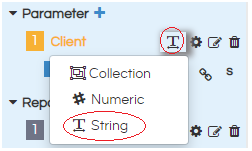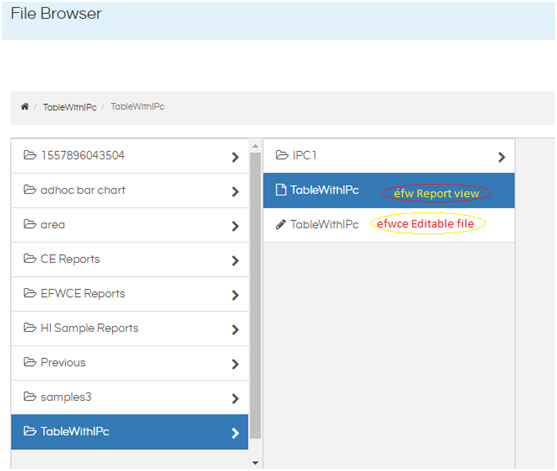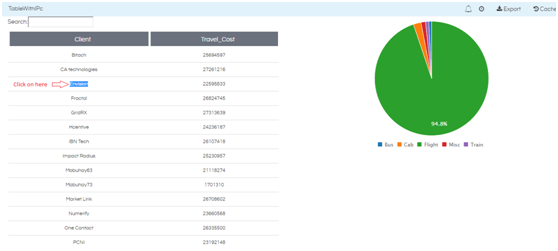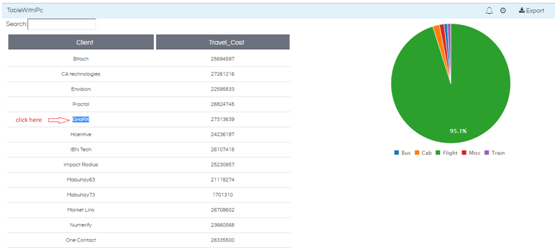Introduction: In this blog we are going to explain how to implement inter panel communication between tabular report and a pie chart in the Dashboard.
For using Inter-panel communication functionality, user needs to create two reports i.e. parent report and child report. Here parent report is Tabular report and Child report is Pie chart.
Parent report: Parent report: Primary report on which we are going to click and pass on the values to the filter of child report.
Child report: Secondary report which will reflect the data according to the click on the parent report columns. This is the child report with the filter, the value to this filter is being passed based on what we have clicked on the parent report.
Note: Child report should have a filter which would be the input parameter to be passed in parent report. It is always better to create the Child report first.
Please make sure you have gone through the blog “Introduction to Community Reporting Interface”
Steps to create pie chart report with single select parameters:
- Data Source
- Dashboard Layout
- Parameter
- Report
1. Data source :
Create data source connection.
Here we are using connection type : plain jdbc

In the configuration of data source, provide the details as shown below.
<driver>com.mysql.jdbc.Driver</driver> // sql driver <url>jdbc:mysql://192.168.2.51:3306/Travel_Data </url> // jdbc url <user>hiuser</user> // database username <pass>hiuser</pass> // database password
Note : Based on your requirement you can connect to other datasources, rest of the steps mentioned below are the same.
2. Dashboard Layout :
In the dashboard layout we basically specify the layout of the report, dashboards, input parameters which we are creating. All the divs are specified here within which they get rendered.
Here we are creating 2 divs: Tabular, Pie_Chart
Report divs are : Tabular, Pie_Chart
When you click on dashboard layout a you will see the following:

In the above screen shot we find two options (left side)
HTML and CSS .
If you click on HTML/CSS the place holder for respective component will be displayed and highlighted in the Dashboard layout panel.
We can place the code related to dashboard layout in HTML and styling in CSS.
Dashboard layout:
HTML :
<div class="col-md-6" id="Tabular"></div> <div class="col-md-6" id="Pie_Chart"></div>
CSS:
In CSS place holder we can add the css related to pie chart customization as well as report customization like back-ground color , report border , border radius, color etc.
3. Parameters :
In the inter panel communication, we pass single value at a time (when we click on the row in the parent report). The parameter must be single select. We should create input parameter by clicking on the + button of parameters section but we should not provide any configuration and SQL because we are passing the value to this parameter when we click on the parent report row.
In this sample we are creating one input parameter of the type “single select”
See the below screenshot, we are creating one parameter.
Note : Generally when we click on add(+) parameter , the parameter is created with default name “parameter1”. We can rename the parameters name with the help of edit icon. In the configuration place holder, by default, configuration code is generated. In this case we should delete all the configurations, then click on apply or control+s.

A. Journey_Type : (single select)
Choose connection as “connection1”(previously created in data sources)
Here “Client” is a Single-select input control, so we need to choose input type as “String” as shown in below image. By default it is always “String”.

Note: For all multi select parameters we should select “Collection” irrespective of parameter datatype. If it is single select parameter we choose the type based on datatype of parameters.
Configuration : Should not provide any configuration.
SQL : Should not provide any sql query.
4. Report :
We can configure different visualizations to render in different divs in the dashboard layout.
When click on add report button, the following layout will appear:

In the left panel we can see report, SQL, Visualization related options.
Click on configure, on the right side we can see the place holders for report configuration, SQL, Visualization. Place the respective code and then click on apply.
Tabular Report configuration:
We need to choose the connection as “connection1”
Configuration:
var dashboard= Dashboard;
dashboard.resetAll();
dashboard.setVariable('Client','Envision')
var Tabular= {
name: "Tabular",
type:"chart",
vf : {
id: "1",
file: "__efwvf_name__"
},
htmlElementId : "#Tabular",
executeAtStart: true
};
SQL :
select `meeting_details`.`client_name` as `Client`, sum(`TravelDetails`.`travel_cost`) as `Travel_Cost` from `TravelDetails` inner join `employee_details` on (`employee_details`.`employee_id` = `TravelDetails`.`Travelled_by`) inner join `meeting_details` on (`employee_details`.`EMPLOYEE_ID` = `meeting_details`.`meeting_by`) group by `Client`
Visualization: Here we are creating custom tabular report. So we need to provide the complete script which is responsible for the table generation. In the script we are using external files : jquery.dataTables.min.js , jquery.dataTables.css , dataTables.jqueryui.css. Please place them( from the back end) in the report folder in the hi-repository . Give the files path in the script where it is required.
Download the External Files here: External Files
Code :
var link = document.createElement("link");
link.href= "getExternalResource.html?path=1562042844398/jquery.dataTables.css"; //put path where you save the file
link.rel = "stylesheet";
var link2 = document.createElement("link");
link.href= "getExternalResource.html?path=1562042844398/dataTables.jqueryui.css"; //put path where you save the file
link.rel = "stylesheet";
var script = document.createElement("script");
if(window.DashboardGlobals)
script.src = window.DashboardGlobals.baseUrl+"/getExternalResource.html?path=1562042844398/jquery.dataTables.min.js"; //put path where you save the file
else
script.src = "getExternalResource.html?path=1562042844398/jquery.dataTables.min.js"; //put path where you save the file
document.getElementsByTagName("head")[0].appendChild(script);
var column_index=[];
var flag;
function tabulate(elem, data, columns) {
var table = d3.select(elem).append("table")
.attr("class"," table display compact width:100%;cellspacing:1 ")
.attr("id","table")
thead = table.append("thead"),
tbody = table.append("tbody");
// append the header row
thead.append("tr")
.selectAll("th")
.data(columns)
.enter()
.append("th")
.text(function(column) { return column; })
.attr('class', function(d, i){ return "colH_" + i; })
.style('background-color','#6c727d')
.style('font-size','15px')
.style('color','white')
.style('border','5px solid white')
.style('text-align','center')
.style('padding-bottom','5px')
.style('@media print','display:none')
.style('padding-left','25px');
// create a row for each object in the data
var rows = tbody.selectAll("tr")
.data(data)
.enter()
.append("tr");
// create a cell in each row for each column
var cells = rows.selectAll("td")
.data(function(row) {
return columns.map(function(column) {
return {column: column, value: row[column]};
});
})
.enter()
.append("td")
.text(function(d) { return d.value; })
.attr('class', function(d, i){ return "col_" + i; })
.attr('align', 'center')
return table;
}
// render the table
var subjectTable = tabulate( '#chart_1', data, Object.keys(data[0]));
script.onload = function(){
$(document).ready(function() {
var table = $('#table').DataTable({"deferRender": true,
"pagingType": "full_numbers",
"lengthMenu": [[5, 10, 25, 50, -1], [5, 10, 25, 50, "All"]],
"paging": false,
"jQueryUI": true,
"ordering": true,
"info": true,
"language": {
"decimal": ",",
"thousands": ".",
"lengthMenu": "Display MENU Records per page",
"zeroRecords": "Nothing Found - Sorry",
"info": "Showing page PAGE of _PAGES_",
"infoEmpty": "No Records Available",
"infoFiltered": "(filtered from MAX total records)"
},
responsive: true,
"fnRowCallback": function( nRow, adata, iDisplayIndex ) {
/* Append the grade to the default row class name */
// console.log(nRow,adata,iDisplayIndex);
if(adata[1]>= 1000 && adata[1]<= 1000000 ){
$(nRow).find('td:eq(1)').css('background-color', '#2eca9c');
$(nRow).find('td:eq(1)').css('color', 'white');
}
else if(adata[1]>= 1000000 && adata[1]< 1500000 ){
$(nRow).find('td:eq(1)').css('background-color', '#fcda52');
$(nRow).find('td:eq(1)').css('color', '#333333');
}
else if(adata[1]> 1500000 ){
$(nRow).find('td:eq(1)').css('background-color', 'white');
$(nRow).find('td:eq(1)').css('color', '#333333');
}
}
});
// var rows = document.getElementsByTagName("tr");
// for (var i = 0; i < rows.length; i++)
// {
// rows[i].onclick = function(d,i) {
// console.log(this, d.name, i);
// dashboard.setVariable('Client',d.name)
// };
// }
// when we click on table row client name , the clicked row value will be passed as parameter to next child report
var tbl = document.getElementById("table");
if (tbl != null) {
for (var i = 0; i < tbl.rows.length; i++) {
for (var j = 0; j < tbl.rows[i].cells.length; j++)
tbl.rows[i].cells[j].onclick = function () { getval(this); };
}
}
function getval(cel) {
console.log(cel.innerHTML);
dashboard.setVariable('Client',cel.innerHTML)
}
// $(document).off('click', '**');
});
}
Note: After placing the configuration, SQL, Visualization then click on apply or (control+s)
Pie chart Configuration : We should provide the listeners, requestParameters as “Client”. when we click on parent report , the row value is passed as filter to the child report.
Configuration :
var Pie_Chart = {
name: "Pie_Chart",
type:"chart",
listeners:["Client"],
requestParameters :{
Client : "Client"
},
vf : {
id: "2",
file: "__efwvf_name__"
},
htmlElementId : "#Pie_Chart",
executeAtStart: true
};
SQL :
select
`TravelDetails`.`Travel_medium` as `Travel_medium`,
sum(`TravelDetails`.`travel_cost`) as `Travel_cost`
from
`TravelDetails`
inner join `employee_details` on (`employee_details`.`employee_id` = `TravelDetails`.`Travelled_by`)
inner join `meeting_details` on (`employee_details`.`employee_id` = `meeting_details`.`meeting_by`)
where
`meeting_details`.`client_name` = ${Client}
group by
`TravelDetails`.`Travel_medium`
Visualization :
if (data.length == 0) {
$('#chart_2').html("<div><h2 style='text-align:center;color:#927333;'>No Data To Display</h2></div>");
} else {
var array1=[];
for (var i = 0; i < data.length; i++) {
var array2=[];
for (var prop in data[i]) {
array2.push(data[i][prop]);
}
array1[i] = array2;
}
var chart = c3.generate({
bindto: '#chart_2',
data: {
columns: array1,
type : 'pie'
},
tooltip: {
show: true
},
legend:{
show: true
}
});
}
Note: After placing the configuration, SQL, Visualization then click on apply or (control+s)
After completing all the steps save the community edition report.
In the back end server location the following files will be generated:
- Efw (report view in the front end)
- Efwce (editable file in the front end)
- Efwvf
- Html
- Efwd
In the front end file browser there are two files which can be seen:

When we double click on the report view file (with the extension efw) report opens like below. The other file with the extension EFWCE can be used to edit the created report/dashboard again.
DashBoard with Inter Panel Communication Report View : (screenshot1)

Screenshot2 :

For more details on EFWCE reporting refer the documentation :
EFWCE method of reporting in Helical Insight
For further assistance, kindly contact us on support@helicalinsight.com or post your queries at Helical Insight Forum
